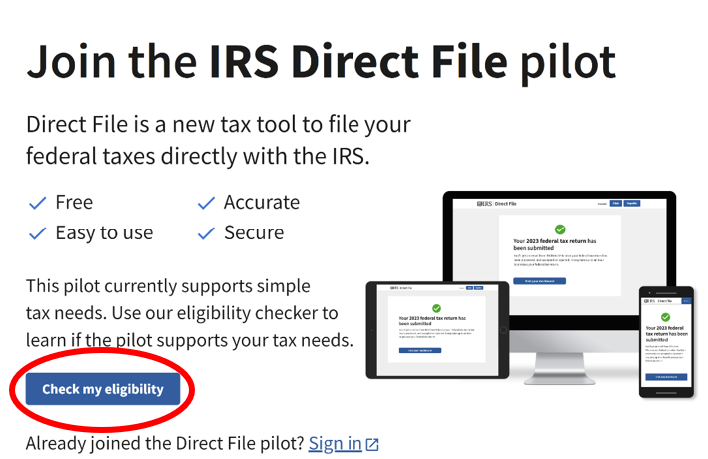By Jessy Dickinson, 2023-2024 Get it Back Campaign Intern
This tax season, the IRS is piloting a new tax filing tool called Direct File. Direct File allows eligible taxpayers to file their federal tax return for free, electronically, directly with the IRS.
You may be able to file your taxes with Direct File if you live in one of the following 12 states: Arizona, California, Florida, Massachusetts, New Hampshire, New York, Nevada, South Dakota, Tennessee, Texas, Washington, or Wyoming.
Click on any of the following links to jump to a section:
- What is Direct File?
- Who can use Direct File?
- What are the benefits of Direct File?
- What do I need to have to use Direct File?
- How do I use Direct File?
- What support is available for Direct File users?
- Who cannot use Direct File?
- How can I file my taxes if Direct File isn’t for me?
- When will Direct File be ready for everyone?
- Resources
What is Direct File?
Direct File is a new free tax filing tool that you can choose to use to file your 2023 tax return. The IRS created it to provide free federal tax return filing directly with the IRS, which has not been available before. Direct File is mobile-friendly and available in English and Spanish.
Visit https://directfile.irs.gov to learn how Direct File can help you file your taxes for free.
Who can use Direct File?
Direct File is available to certain taxpayers who lived in one of the 12 pilot states in 2023. To use Direct File, you must have an IRS online account. If you do not have an account, you will need to create one using ID.me.
To understand if Direct File is useful for your tax needs this year, use the Check My Eligibility Tool. Eligibility is based on state residency, income sources, tax deductions, and other information. The Check My Eligibility Tool is the most accurate way to understand your eligibility for Direct File.
What are the benefits of using Direct File?
There are 8 key benefits to using Direct File:
- Free: Direct File is completely free to use. The no-cost aspect of the tool is built into its design.
- Security: The IRS is committed to prioritizing your security. Direct File uses ID.me to help prevent identity theft and to protect your data.
- Privacy: The IRS will not share any information provided through Direct File with other government agencies.
- Available on different devices: You can use Direct File on a smartphone, tablet, or desktop computer.
- Step-by-step guidance: Direct File features a filing checklist which you can access before, during, and after filing your taxes with the tool. The checklist helps users track their information to make sure all steps are completed properly.
- Live support: you can get answers to questions you have while filing through real-time online support from trained IRS customer service representatives in English and Spanish.
- Start and finish later: If you start using Direct File but cannot finish at that time, you can pick up where you left off later. All information that you added before will be saved.
- Download or print your return when you are ready: If you are using your phone and unable to save or print your tax return, you can do this later when you can connect to a printer.
What do I need to have to use Direct File?
First, you need to have an IRS online account. The IRS partners with ID.me to access certain online IRS services, including Direct File. You will need to sign-in to your ID.me account to file a tax return with Direct File. If you do not have an ID.me account, you must create one.
To use Direct File, you need to have the following:
- ID.me Online Account
- Taxpayer Identification Number for yourself, any spouse, or any dependents you claim.
- This may be a Social Security Number (SSN), Individual Taxpayer Identification Number (ITIN), or an Adoption Taxpayer Identification Number (ATIN) for dependents.
- Current driver’s license, state identification, U.S. passport. or U.S. passport card
- 2023 tax documents such as your Form W-2 (for income from an employer) or Form 1099-G (for unemployment compensation)
- Internet access
Additionally, if the IRS sent you, your spouse, or your dependents an Identity Protection PIN (IP PIN), you will need the 6-digit number assigned to you.
How do I use Direct File?
There is no software to buy or install for Direct File. It is mobile-friendly, which means you can use Direct File on a phone, tablet, or computer. The tool is available in English and Spanish.
When you go to https://directfile.irs.gov, click the link to sign in to your account. Direct File features a step-by-step checklist that guides you through the filing process. You will:
- Enter your personal tax information directly into the Direct File tool.
- Receive a clear summary of your 2023 federal taxes based on the information you entered.
- Submit your return once you’ve reviewed it.
After you file your return, Direct File will send you an email confirmation. Direct File will send another email when the IRS accepts your return for processing.
If you are a resident of a state with state-level income taxes (Arizona, California, Massachusetts, or New York), you will be directed to a state-run filing tool after using Direct File. The state-run filing tool will help you easily file your state return for free. In most states, you will be able to export your Direct File data to the state processing tool. This means filing your state return will only take a few more minutes! Learn more about state filing tools on the Direct File website.
What support is available if I need help using Direct File?
If you need help while filing your return in Direct File, there is real-time live chat support from IRS customer service representatives in English and Spanish. The chat support does not use chatbots and comes from real humans who have been trained to assist users. Customer service is available whether you file on your smartphone, tablet, or desktop computer.
Live online support is available Monday through Friday from 7:00 AM to 10:00 PM Eastern Standard Time and on Saturday and Sunday, from 11:00 AM to 5:00 PM Eastern Standard Time. If the chat support does not answer your question, you can request a phone call on a toll-free line to speak with an IRS customer service representative.
Customer service representatives can:
- Provide technical support.
- Clarify tax laws related to Direct File.
- Explain tax forms and tax terms used within the Direct File tool.
- Answer Direct File timeline questions.
Customer service representatives do not have access to your IRS data and cannot provide personal tax advice. Customer service representatives follow the IRS Privacy Policy which describes users’ privacy rights and steps the IRS takes to keep your personal information safe.
Who cannot use Direct File?
Since Direct File is in a pilot year, you cannot use the tool if you did not live in one of the 12 pilot states in 2023: Arizona, California, Florida, Massachusetts, New Hampshire, New York, Nevada, South Dakota, Tennessee, Texas, Washington, or Wyoming. If Direct File is successful, it is expected to expand to more states and situations in future years.
You cannot use Direct File if you did not live in one of the 12 pilot states in 2023: Arizona, California, Florida, Massachusetts, New Hampshire, New York, Nevada, South Dakota, Tennessee, Texas, Washington, or Wyoming.
You cannot use Direct File if you have income from gig work, tips, or online marketplaces. You can use Direct File if you have income from certain sources, such as Form W-2, Social Security benefits, or unemployment compensation.
Direct File currently can process tax returns claiming the Earned Income Tax Credit, the Child Tax Credit, and the Credit for Other Dependents. You cannot use Direct File to claim other tax credits.
You cannot use Direct File if you need to itemize deductions. Direct File only supports standard deductions right now.
There are other guidelines for using Direct File. It is best to use the Check My Eligibility Tool to determine if you can use Direct File.
How can I file my taxes if Direct File isn’t for me?
Direct File is just one option for filing your taxes this year. You can choose the filing method that is best for your personal situation.
If you are out of the scope of eligibility, or if the Direct File tool is not the best fit for you, consider using an IRS-sponsored free tax preparation program. Volunteer Income Tax Assistance (VITA) and AARP Tax-Aide provide free tax preparation for those who earn less than about $60,000. Contact your local free filing site to learn more.
Additionally, other options include free online tax filing services like MyFreeTaxes.com or GetYourRefund.org.
When will Direct File be ready for everyone?
Direct File opened to the public on March 12, 2024. After reviewing the pilot results, the IRS will evaluate whether it will offer Direct File in the future. There is not a set timeline for Direct File to expand to other states or users. Stay tuned for updates about Direct File after the 2024 filing season. Learn the latest about what’s happening with the Direct File pilot here.
What is the difference between IRS Direct File and IRS Free File?
IRS Direct File and IRS Free File are both tax filing services. However, there are key differences between the two programs. IRS Direct File is run directly by the IRS and is offered as a pilot for the tax filing season in 12 states only during 2024. Since it is in its first year, Direct File can process certain types of income and tax credits. Direct File is a digital-only tool that allows people to file their tax returns directly with the IRS securely and completely free. Direct File users will create ID.me accounts directly with the IRS to use the tool. Direct File has partnered with states that have state filing requirements for seamless integration to file state returns for free.
IRS Free File is a public-private partnership between the IRS and tax preparation software companies. Free File is available in all 50 states. Free File offers two options to file a tax return electronically: guided tax filing software and e-fillable forms that individuals use to self-prepare their taxes. Free File users must compare different tax software and choose which option is best for them, which requires some research and understanding of taxes to make an informed decision. To use Free File, users will create a new account with the chosen tax software company or log-in if they already have an account. Some Free File companies charge to file state returns.
___________________________________
Resources
- General tax information: what you need to know to file taxes in 2024.
- Unsure if you should file a tax return? Find out do you need to file taxes?
- Understand the different online filing options you can choose for your taxes, including Direct File.
_____________________________________









